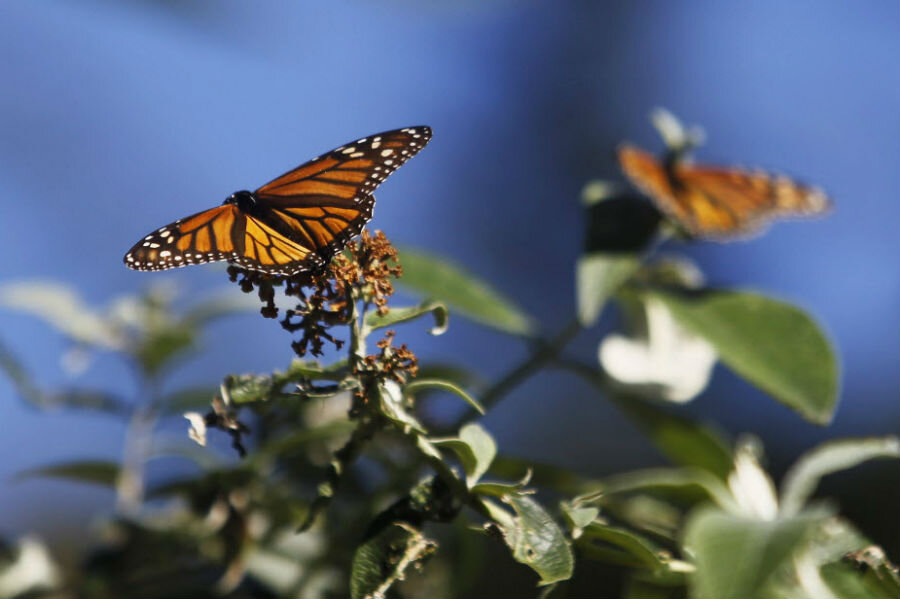Are monarch butterflies dwindling or rebounding?
Loading...
Earlier this year, the monarch butterfly seemed to be starting a comeback after 20 years of habitat loss took a serious toll on its population.
The insect, which is known for its distinctive orange-and-black wings and dramatic migration pattern that has some butterflies cover a distance of up to 3,000 miles, seemed to be responding positively to joint conservation efforts from the United States, Mexico, and Canada earlier this year.
But this summer's monarch butterfly counts have yielded alarmingly low numbers of the species, compared with last year.
While the species as a whole is not at risk of extinction, Jason Weintraub, an entomologist at Drexel University's Academy of Natural Sciences in Philadelphia tells The Christian Science Monitor, two key “metapopulations” are in serious decline. What’s more, the decline of the monarch is emblematic of the loss of wild habitat throughout much of North America, and with it an army of pollinator insects that play a key role in human food production.
"Our food supply depends on insect pollination," Dr. Weintraub says in a telephone interview, adding that we all are dependent on the work of "hundreds of thousands of different species of bees, wasps, flies, beetles, butterflies, and moths."
The monarch, like many insect species in North America, is struggling from loss of habitat. According to Monarch Watch, an organization based at the University of Kansas, there have been significant losses of habitat for these monarchs in their summer breeding grounds in the US, as well as their overwintering sites in central Mexico. During winter, loss of tree cover due to illegal logging and a surging population of bark beetles leaves monarchs susceptible to predators and the elements. In the US, monarchs lose up to 6,000 acres of potential habitat a day due to land development, Monarch Watch says.
Another problem is the butterflies' source of food. Monarch caterpillars will only eat milkweed, which used to grow abundantly in the Midwestern US. But milkweed didn't fit into the agricultural trend of monocropping, the practice of growing large fields of a single crop, and in recent decades became a casualty of aggressive weed control practices.
Yet conservation efforts seemed to be yielding positive results in March. Monarchs appeared to be on the rebound, the Monitor reported: the butterflies blanketed a 10-acre area in Mexico this winter. This was more than 3.5 times greater than the previous season, which saw 2.8 acres of butterflies, with a record low of 1.66 acres in 2013.
"The increase is certainly great news, but the bottom line is that monarchs must reach a much larger population size to be resilient to ever-increasing threats," Tierra Curry, a senior scientist at the Washington, D.C.-based Center for Biological Diversity, told the Monitor in March.
Those words turned out to be darkly prophetic.
Later that month, a massive storm brought high winds, rain, and cold to the butterfly's overwintering ground in Mexico's pine and fir forests, claiming an estimated 6.2 million butterflies and felling more than a hundred acres of forests that the butterflies depend on for shelter in the winter, according to Weather.com. While similar storms in the area are not unheard of, this storm was unexpectedly intense, fueled by shifting temperatures due to climate change.
It is hard to say how badly the storm affected the rebounding population, but current butterfly counts are not looking good for the monarch. But while the butterfly may be struggling now, conservationists hope it can rebound again with a little help.
Over the past several years, various multinational conservation efforts have been implemented across North America to preserve the butterfly. Recently, the Obama administration created a "fly-way" for the insect, planting milkweed along highways along the monarch's migration path to Mexico. According to the national strategy plan released by the White House, the fly-way is intended to increase the population to 225 million butterflies by 2020.
Non-government groups have also begun campaigns to plant milkweed, sometimes giving away the plants for free. Other groups are petitioning the US government to designate the monarch butterfly an endangered species, which would entitle the species to increased protections.
"The neat thing about monarch and pollinator conservation is that you can do it anywhere," ecologist Scott Black, the executive director of the nonprofit Xerces Society for Invertebrate Conservation, based in Portland, Ore., told the Monitor in 2015. "You can take a park or a school yard, put in flowering plants and milkweed, and make sure to keep out herbicides. Everybody can take action."






